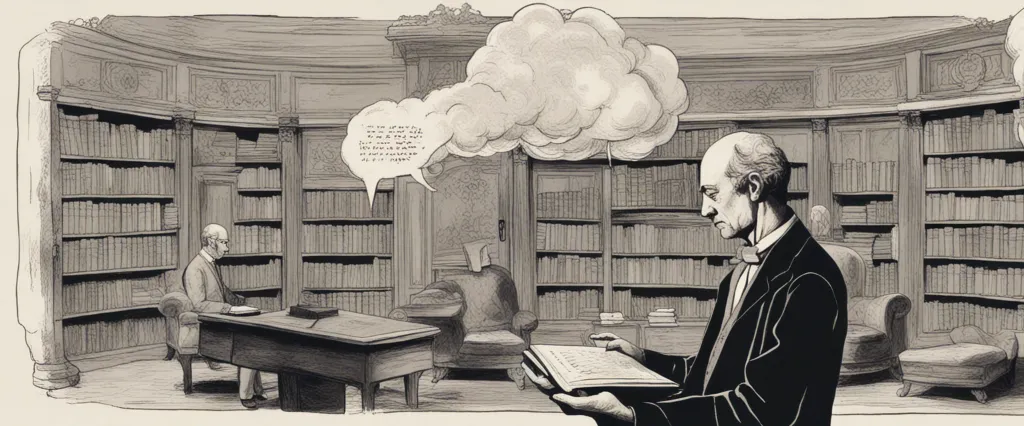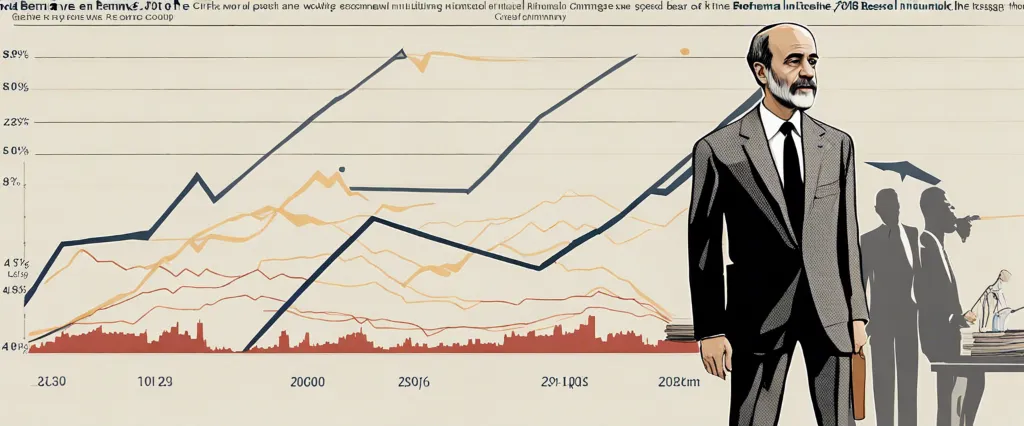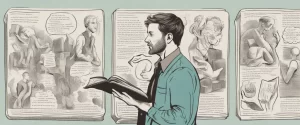——The House of Morgan by Ron Chernow & The Federal Reserve and the Financial Crisis by Ben Bernanke

In the realm of financial powerhouses, few entities have shaped the course of global economics as profoundly as J.P. Morgan & Co. and the Federal Reserve. While their names are synonymous with the ever-evolving landscape of banking and finance, the stories behind these institutions have often remained veiled in mystery.
Unveiling the intrigue and influence that both the House of Morgan and the Federal Reserve have exerted on the economic fabric of nations, this comparative study delves into the depths of two seminal books: “The House of Morgan” by Ron Chernow and “The Federal Reserve and the Financial Crisis” by Ben Bernanke. Through a meticulous exploration of these literary works, this study aims to examine the intersections between the birth, growth, and impact of these monumental institutions.
In Ron Chernow’s extensively researched masterpiece, “The House of Morgan,” the intricate details of J.P. Morgan & Co.’s ascent to unrivaled prominence in the world of finance are revealed. Chernow traces the entwined history of this influential banking dynasty and American capitalism, paying meticulous attention to the lives and strategies of key individuals who shaped the firm’s trajectory. By illuminating the complex relationships between J.P. Morgan & Co., government entities, and global financial markets, Chernow exposes the inner workings of this formidable institution.
On the other hand, “The Federal Reserve and the Financial Crisis” by Ben Bernanke chronicles a more contemporary narrative. Bernanke, the former chairman of the Federal Reserve during one of the most significant economic crises of our time, provides an insider’s perspective on the inner workings of the central banking system. Drawing upon his expertise and experience, Bernanke weaves together an intricate narrative, shedding light on the Federal Reserve’s role in stabilizing the financial system amid turmoil and the subsequent aftermath of the crisis.
Through an interdisciplinary comparative analysis, this study seeks to explore the complementarity and contrasting themes between these two pivotal books. By discerning the historical, socio-political, and economic contexts that shaped the House of Morgan and the Federal Reserve, we can gain a nuanced understanding of how these institutions have shaped and been shaped by the complexities of the financial world.
As we embark on this comparative journey, we will examine the parallels and divergences in the storytelling techniques employed by Chernow and Bernanke, analyzing their distinct narrative styles, sources of information, and intended audiences. Furthermore, we will critically evaluate the authors’ perspectives and biases, taking into account the broader implications for our understanding of the intricate connections between finance, power, and the global economy.
In unlocking the untold narratives behind these pivotal institutions, this comparative study aspires to provide a holistic and comprehensive understanding of the House of Morgan and the Federal Reserve. By elucidating the profound impact that these entities have had on global financial systems, we hope to shed light on the enduring legacies of two institutions that continue to shape the course of financial history.
Brief Summary of Two Books
The House of Morgan by Ron Chernow
The House of Morgan” by Ron Chernow is a comprehensive historical account of the influential Morgan banking dynasty. The book primarily focuses on the four major figures who shaped the legacy of the family and their role in the development of American finance: Junius Spencer Morgan, J. Pierpont Morgan, Jr., Henry Sturgis Morgan, and Junius Spencer Morgan III.
Chernow begins the narrative by delving into the life of Junius Spencer Morgan, who laid the foundation for the Morgan banking empire in the mid-19th century. He explores Junius’ rise as a highly successful financier and his pivotal role in arranging loans for the US government during times of crisis.
The book then shifts focus to J. Pierpont Morgan, Jr., commonly known as J.P. Morgan, who took over the helm of the family firm and became one of the most powerful figures in American finance. Chernow highlights J.P. Morgan’s involvement in major corporate mergers and acquisitions, his role as a leading banker in the creation of US Steel, and his crucial position as a financial savior during several economic panics.
Next, Henry Sturgis Morgan, J.P. Morgan Jr.’s son, is explored as he navigates the complexities of Wall Street during the early 20th century. Chernow reveals Henry’s efforts in expanding Morgan’s global reach and his close relationship with industrial tycoons like Thomas Edison.
Finally, the book concludes with an examination of Junius Spencer Morgan III and his efforts in modernizing the family bank after World War II. Junius’ struggles in balancing tradition with the changing financial landscape are explored, shedding light on the decline of Morgan’s dominance in the banking world.
Throughout the book, Chernow discusses the Morgan family’s significant influence on American politics and finance, their involvement in major historical events such as World War I, the Great Depression, and their relationships with powerful figures such as Franklin D. Roosevelt and Winston Churchill.
Overall, “The House of Morgan” is a sweeping historical narrative that provides an in-depth exploration of one of the most prominent and influential banking families in American history, offering insights into the evolution of finance and the dynamics of power and influence.
The Federal Reserve and the Financial Crisis by Ben Bernanke
“The Federal Reserve and the Financial Crisis” by Ben Bernanke is a comprehensive examination of the 2008 financial crisis and the subsequent actions taken by the Federal Reserve to mitigate its impact and stabilize the economy. Bernanke, who served as the Chairman of the Federal Reserve during the crisis, offers an insider’s perspective on the events that unfolded and the decisions made by the central bank.
The book delves into the factors that led to the crisis, including the housing bubble, excessive risk-taking by financial institutions, and regulatory failures. Bernanke explains how these factors culminated in the collapse of major financial institutions such as Lehman Brothers and Bear Stearns, triggering a severe downturn that spread globally.
Bernanke then details the extraordinary measures taken by the Federal Reserve to confront the crisis head-on. He explains the rationale behind unconventional policies such as quantitative easing and the injection of liquidity into financial markets, providing a detailed account of the Fed’s decision-making process.
Furthermore, Bernanke addresses the criticisms and controversies surrounding the Federal Reserve’s actions during the crisis. He discusses the potential moral hazard that comes with intervening in financial markets and debates the effectiveness of the measures taken in speeding up economic recovery.
In addition to explaining the crisis and the Fed’s response, Bernanke also highlights the lessons learned from the experience. He explores the importance of regulatory reforms, improvements in risk management, and the need for a comprehensive framework to handle future crises more effectively.
Overall, “The Federal Reserve and the Financial Crisis” offers a unique perspective on the events of the 2008 crisis, providing insights into the challenges faced by policymakers and the actions taken to prevent a complete economic collapse. It serves as a valuable resource for those interested in understanding the role and effectiveness of the Federal Reserve in times of financial turmoil.
Comparison between Two Books

Similarities in Financial Documentary
Both “The House of Morgan” by Ron Chernow and “The Federal Reserve and the Financial Crisis” by Ben Bernanke are financial documentaries that explore the complex world of banking and finance, shedding light on the inner workings of these institutions. Despite being written by different authors and focusing on different aspects of the financial world, both books share some similarities in their approach and themes.
1. In-depth analysis: Both books provide readers with an in-depth analysis of the financial industry, going beyond surface-level explanations to unravel the intricacies of the banking system. Chernow and Bernanke delve into the history, policies, and key players of the financial world, making complex concepts accessible to the average reader.
2. Historical context: Both books place their narratives within a historical context, which helps readers understand how the financial system evolved and its impact on society. Chernow focuses on the House of Morgan, tracing its history from the 19th century to the modern era, while Bernanke’s book focuses on the Federal Reserve’s role in the financial crisis of 2008.
3. Insider perspective: Both authors provide an insider’s perspective on the financial industry. Chernow draws on extensive research and interviews to present an intimate portrait of the individuals behind the House of Morgan, while Bernanke, as the former chairman of the Federal Reserve, offers firsthand insights into the decision-making processes within this institution during the financial crisis.
4. Attention to detail: Both books exhibit a meticulous attention to detail, leaving no stone unturned in their exploration of the financial world. Chernow and Bernanke provide comprehensive accounts of the intricate mechanisms, policies, and historical events that shaped the financial industry and its various crises.
5. Emphasis on consequences: Both books emphasize the consequences of financial decisions and actions. Whether it’s the impact of Morgan’s influence in the creation of monopolies and the Great Depression (as explored by Chernow) or the aftermath of the Federal Reserve’s response to the financial crisis (as explored by Bernanke), consequences are analyzed in detail to demonstrate the far-reaching effects of financial events.
Overall, while each book has its distinct focus and scope, “The House of Morgan” and “The Federal Reserve and the Financial Crisis” share a common ground in their dedication to shedding light on the world of banking and finance, providing readers with comprehensive, well-researched, and insightful analyses of the financial industry and its impact on society.
Divergences in Financial Documentary
The House of Morgan by Ron Chernow and The Federal Reserve and the Financial Crisis by Ben Bernanke are both highly regarded books that delve into the world of finance and provide insightful information about the workings of major financial institutions. While they share a common theme, there are notable divergences in their approach, focus, and perspectives on the financial documentary.
One significant difference between the two books is the scope of their coverage. The House of Morgan takes a historical approach, exploring the rise and influence of the famous banking family, the Morgans, over several decades. Chernow traces the family’s beginnings, their involvement in major financial events, and the impact they had on the nation’s economy. In contrast, The Federal Reserve and the Financial Crisis by Ben Bernanke has a more specific focus on the financial crisis of 2008 and the role played by the Federal Reserve in mitigating its impact. Bernanke, who served as the Chairman of the Federal Reserve during the crisis, offers a firsthand account of the events and decisions made during that period.
Another difference lies in the authors’ backgrounds and perspectives. Chernow, known for his in-depth research and biographical approach, brings a historical and objective lens to The House of Morgan. While he analyzes the actions of the Morgans and their influence, Chernow is not inherently tied to the financial industry. In contrast, Bernanke, a former academic economist and the head of the Federal Reserve during the crisis, brings his insider knowledge and experiences to The Federal Reserve and the Financial Crisis. His book provides a more technical and policy-oriented analysis of the events surrounding the crisis, making it a more detailed and specialized account.
Additionally, the writing style and accessibility of the two books differ. Chernow’s The House of Morgan is renowned for its engaging and fluid narrative that appeals to a broader audience. He weaves in personal stories, anecdotes, and historical events effectively, making the book accessible to readers with varying levels of financial knowledge. In contrast, Bernanke’s The Federal Reserve and the Financial Crisis takes a more academic and technical approach, reflecting the author’s expertise. The book may be more suited for readers already familiar with economic and financial terminology, as it delves into detailed discussions on monetary policy and economic theory.
In summary, The House of Morgan and The Federal Reserve and the Financial Crisis offer distinct perspectives on the financial documentary. Chernow’s historical account of the Morgan family offers a broader coverage of their influence on the nation’s financial system, while Bernanke’s book focuses on the Federal Reserve’s response to the 2008 crisis. Chernow’s writing style is more approachable, while Bernanke’s book is more specialized and technical. By considering these divergences, readers can choose the book that aligns best with their interests and desired level of depth in understanding financial history.

Conclusion
Both “The House of Morgan” by Ron Chernow and “The Federal Reserve and the Financial Crisis” by Ben Bernanke are highly regarded books in the field of finance and economics. The choice between the two largely depends on the reader’s interests and preferences.
“The House of Morgan” offers an extensive historical account of the renowned Morgan banking dynasty, tracing its influence and impact on the financial world from the late 19th century to the present. This book delves into the intricate workings of one of the most powerful and influential financial institutions in American history, making it a compelling read for those interested in the evolution of finance, Wall Street, and the broader economic landscape.
On the other hand, “The Federal Reserve and the Financial Crisis” by Ben Bernanke provides a detailed analysis of the 2007-2008 global financial crisis and the role played by the Federal Reserve, where Bernanke served as Chairman. The book presents an insider’s perspective, offering insights into the decisions made by the Federal Reserve during the crisis and its efforts to stabilize the financial system. This book is recommended for those interested in understanding the workings of the Federal Reserve, monetary policy, and the causes and consequences of the financial crisis.
Ultimately, both books are valuable in their own right, offering different perspectives on significant events and institutions in the financial world. If you are more interested in finance history and the influence of powerful banks, “The House of Morgan” may be more suitable. If you are seeking a deeper understanding of the financial crisis and the role of the Federal Reserve, “The Federal Reserve and the Financial Crisis” would be a top choice.


